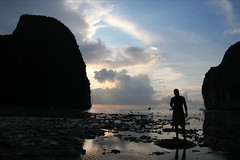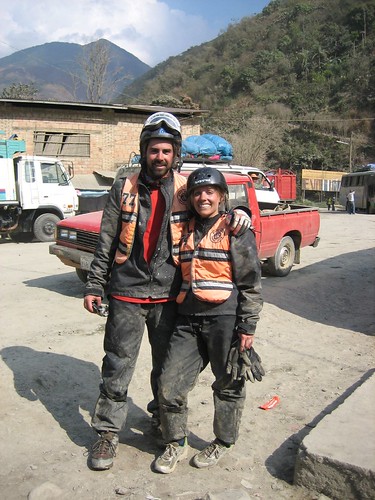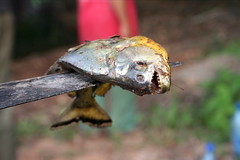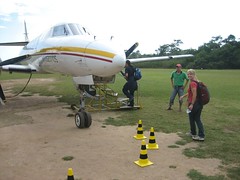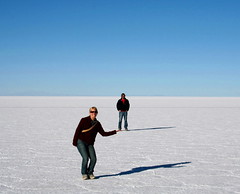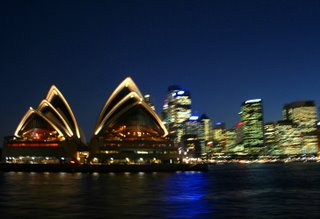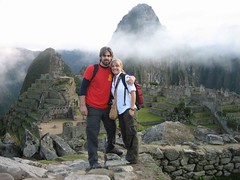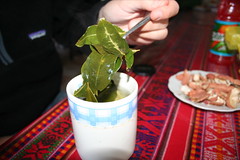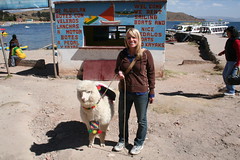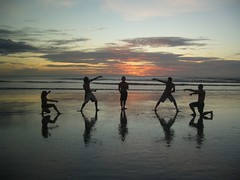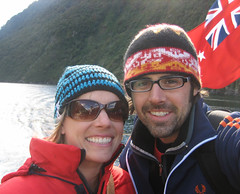Day 1: Welcome to NZ?
Our first day in NZ was not a very good one. All due to one ill-tempered immigration official that threatened to deport us back to the U.S. You see, during our first 3 and a half months traveling in South America, we bought our plane, train, and bus tickets as we went, seeing that we did not really know how long we would spend in each country upon arrival. So, we did the same for New Zealand, thinking that we would arrive, figure out how long we would need to travel around the country, and buy our ticket out within a week or so of being there. Wrong. Word to the wise: if you plan to travel to New Zealand, be sure that before you arrive, you already have your departure ticket. (This wasn’t necessary for Australia, or any other country we’ve been to so far, for that matter.) As for us, upon arriving in Auckland at 5am after a 14-hr plane ride from Buenos Aires, we spent our first 5 hours not really sure if we were going to get past the airport. After threatening to deport us, we asked the official if we could buy our outgoing tickets to Australia right then. He agreed if both Mike and I could show him a visa for Australia. However, the Australian tourist visa is an ETA, an electronic visa. You have no physical visa document; you are just in their computer system and your airline will verify that you have it set up before you depart. Somehow this official didn’t understand that (maybe it was his first day) and he demanded to see some sort of printout, whatever it might be. So, thanks to the friendly people at Air New Zealand, we managed to get printouts, literally a piece of paper with our name and “OK to board” written on it. This seemed to work (although I think the Air New Zealand guy helped us out a lot by sweet talking some sense into this snooty official) and we booked an Air New Zealand flight to Sydney for 18 days out. Finally, we saw the bright New Zealand sunshine and felt the brisk outside air!!
Day 2: Big City Auckland
By our second day in NZ, our travel and jetlag issues were behind us, and we had settled into the Beyond Backpackers hostel in downtown Auckland. Ahh, the luxury of being back in an English-speaking country. It actually took us some time to realize that before placing an order in a restaurant or asking a question, we didn’t have to figure out how to say it in Spanish or Portuguese.
Knowing that we only had 18 days to pack in all of our New Zealand travels, we quickly made use of our time and booked a tour around both the North and South islands of New Zealand on the Magic Bus, recommended by the travel agency in our hostel. After settling that, we headed out to one of Auckland’s biggest attractions, Kelly Tarlton’s Antarctic Encounter & Underwater World. The best part of this attraction was the Imperial penguins, an exhibit that recreated the penguins’ natural habitat in Antarctica. We hopped in a snow cat to view the penguins swimming and hanging out on their man-made snow banks. The penguins were so cute that we jumped on the snow cat again for a second round of penguin watching!
Day 3: First day on the Magic Bus, Auckland to Rotorua
While waiting for the bus, we didn't fully know what to expect from this "Magic Bus Adventure". The brochures looked nice and everyone in them looked like they were having a blast, but still reeling a bit from the immigration official and having experienced all sorts of buses in South America, our guards were up. The bus was a little late, but when it did arrive it was full of life, or at least the bus driver, Stella, her microphone, and sound system were. She had techno dance beats cranked and was singing along to the intermittent vocals. It was funny to see a young girl in her early twenties behind the wheel of this behemoth of a bus. Stella kept things lively, squeezing every NZ catch phrase in her loud, and sometimes long-winded, explanations over the bus mic. "Sweet as", a common phrase in NZ, was by far her favorite. She was great and a good introduction to what was to be expected of the rest of our trip.
The bus made a quick stop at a lookout on the rim of an extinct volcano over downtown Auckland, and then it was on the open road headed for Rotorua and the heart of Maori culture. The bus trip itself was great with incredible views of rolling green hills, unlimited rainbows, and heaps of sheep! Apparently, NZ has a population of 4 million people and 40 million sheep.
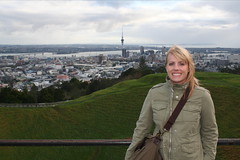
Before making it to Rotorua, we had a stop at the Waitomo glowworm caves. Jen & I suited up in full wet suits, rubber boots, spelunking hard hats equipped with headlights and, with the help of our guide, braved the freezing cold waters and pitch black. We did what they call a black water rafting tour, which is a tour through dark, underground caves on an inner tube, like "toobin", but without the beer, sun, or red necks. So we were in our tubes, floating down an underground river and looking up at these tiny worms glowing 10 or so feet above. When we turned off our headlights, they lit up the cave's ceiling like a starry night sky. It wasn't a completely passive tour though, it is New Zealand and we had some semi-extreme sport action. At one stage we dropped our tubes 6 feet down a water fall and with the urging of our guide, turned around, with the drop to our backs and with our heels to the edge of the water fall and fell straight back, pretty crazy in the pitch black. There was also a nice big natural water slide near the end. Our guide was great and the caves were something else, well worth the money.
We dried off, jumped back on the Magic bus, and made it to Rotorua before we knew it. This entire NZ trip was jammed pack with stuff and Day 3 was no exception. We threw our stuff in our room and made it onto a different tour bus for the ride out to a Maori museum, recreated village, and enormous Maori feast. The tribe recreated what a Maori village would have been like before the English came to NZ, and then they performed a traditional dance show, the haka, with a lot of wide-eyes and tongues sticking out. Afterwards we enjoyed a huge Maori buffet, by far my favorite part of the evening, lots of meats and sides...my kind of spread.
Day 4: Rotorua to Taupo
Beginning our day early at 8am, as most days with the Magic bus are, we set out to check out some of Rotorua’s finest bubbling mud. Rotorua, in all its thermal active glory, has all the mud pools, geysers, craters, and nasty egg smells that you could ever need. We took it all in at the Wai-O-Tapu Thermal Wonderland, which hosts some great walks to explore these thermal landscapes.
Next, after checking out the rushing, turquoise water of the Huka Falls, we arrived at the Taupo Rock ‘N’ Ropes course. First up, the trapeze jump. For this, we had to climb to the top of a wooden pole, similar to a telephone pole, and then stand on top of the pole, keeping our balance on a piece of wood with a diameter smaller than our feet. In front of us was the trapeze, a bit unrealistic for someone of my height to reach, but Mike wants to make sure that I mention that he grabbed a hold of it with no problem. No worries on my part though, my harness caught me in time. Next up was the giant swing. Harnessed in, this 3-second free-fall/swing was exhilarating albeit a bit scary. Afterwards, I mentioned to our instructor that after doing the swing I was a bit scared to sky dive, which we were scheduled to do later that afternoon. He promptly replied, “Skydiving is nothing compared to the swing.” Unfortunately, due to cloudy weather, our first of three attempts at skydiving was cancelled.
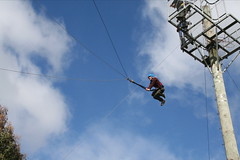
Day 5: Second Attempt at Sky Diving
We started our second day in Taupo with a 10am appointment to sky dive over Lake Taupo. We show up, get fully dressed in our sky dive suits and leather aviator hats, meet our instructors who will be attached to us as we make the leap out of the plane, and what happens…well, clouds happen. Clouds are a no go for skydivers and unfortunately, they didn’t let up all day. The sky dive company kept moving our appointment back, to noon and then to 2pm and then 3pm and finally we realized it wasn’t going to happen. We accepted our unfortunate luck and prepared for a long day of walking the following day at the Tongariro Crossing.
Day 6: Tongariro Crossing
One of the highlights of our NZ trip, the Tongariro Crossing, was, as the Lonely Planet says, "the best one day walk in New Zealand". It was winter time for our walk, and for the majority of the trek we were knee deep in powdery snow, which made it a bit more challenging than we first suspected, though the crampons the guides handed out before the crossing should have been a good indication. The trek started with an easy incline through a valley peppered with small shrubs and grasses, with "Mt. Doom" towering on our right (I believe the actual name is Mt. Ngauruhoe, though I prefer Mt. Doom). As we went, the path became more taxing, with a few pretty steep sections, then a long flat part that reminded us of Siberia, granted we haven't been there… yet, but it looked just like what we imagine Siberia looks like; flat, wind blowing snow everywhere and little visibility. Every so often we would turn around at the end of a steep section, rest and take in the ever changing and magnificent views. As we scanned the horizon, we saw the bright greens in the far distance, then the brown desert vegetation, and then closer still the white untouched powder of the mountain we were slowly conquering. When we finally made it to the pinnacle of the climb we ate lunch on a thermal patch of ground, where the snow was completely melted and the skin of the mountain was exposed. It was graveled volcanic rocks embedded in warm, slightly damp dirt. Lunch was inhaled quickly since it was extremely cold and the wind blew at gale force speeds.
We packed up, but instead of walking down the other side the mountain, which consequently is a volcano, hence the thermal activity, we "bum slid" into the crater. Bum sliding consists of one tucking all loose clothing into the waist of your pants, sitting on the edge of a nice steep decline, pushing yourself off and trying to gain as much speed as possible. With visibility at nearly zero we took our guides word for it and slid some 500 yards into the haze and powder into the mouth of the volcano's crater. It was scary, but great fun.
We then walked another long flat stretch that ended at a lookout point that offered the best view of the walk. We looked out over a number of lakes in the distance, with rolling hills closer, then forest and then snow covered mountains in the foreground. Descending the far side of the mountain range was much easier than the ascent. The scenery was quickly changing, snow still covered the ground, but bushes, rocks and small trees began to make appearances. We had one more bum slide, this one was different in that we could see where we were headed and we had a few more obstacles to contend with, grass and intermittent rocks, still well worth the hazards.
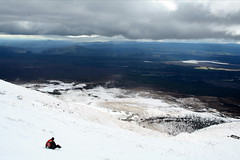
We carried on down towards the end of the trail and the surroundings continued to change. We came upon a thermal creek with steam rising over its bright red moss covered rocks and boulders. We continued to hike and the shrubs continued to increase in size until we reached dense rainforest with snow fed streams winding themselves through the green ferns and moss-covered trees. At the end of the trek we shed our soaking wet borrowed boots, pants and jackets and happily drank the free beer provided by the tour guides. After an eight-hour hike through powder snow, tundra, and rainforest, Jen and I slept very, very well that night.
Day 7 & 8: Wellington
After a good, long stop in Taupo, we jumped back on the Magic bus and headed to Wellington, the very south point of New Zealand’s North Island. This day consisted mainly of driving, with a few scenic stops, including a great view of the snow-capped Mt. Ngauruhoe. This mountain is also known as Mt. Doom in reference to its usage as the Mordor mountain in the Lord of the Rings.
Later that day, we arrived in Wellington, capital of New Zealand and home of Peter Jackson. Also home to a friend of ours, Trey, from back home in Austin. Wellington is a clean and bustling city. A bit chilly in the winter, but lots of great restaurants, cafes, museums, and harbor walks, all compacted into one small capital city. Trey was kind enough to show us around and treat us to a meal at one of his favorite local restaurants. Our second night there, we headed out with Trey to his work’s quiz night at a local pub. With images of “The Office” in mind, we began a fun night of mingling with the friendly local Kiwis and taking part in this oh so very British pastime.
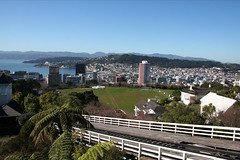
Day 9: South Island
Leaving Wellington and the North Island, we jumped on the ferry and headed to the city of Picton in the South Island. Our dear Magic bus greeted us at the ferry terminal, along with our new bus driver, Karl, who would turn out to be our driver for the rest of our NZ travels. Karl drove us down to Nelson, where we spent our first night. Nelson, being the quiet town that it is, didn’t offer us much other than a good example of a typical small NZ town, but it did have a quite beautiful setting by the water along with some exceptional jewelry shops.
Day 10: The West Coast
The beautiful western coastline of NZ’s South Island took up most of this day, including the famous “pancake rocks” in Punakaiki. Due to a weathering process known as stylobedding, these rocks form as though they are pancakes stacked one atop the other, often with blowholes of water surging in at various points. Altogether, it was a beautiful coastal area with plenty of photo-ops.
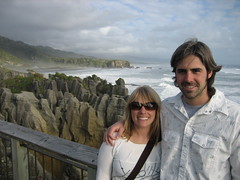
We arrived in the small town of Greymouth in the late afternoon. We checked into our hostel, in which each room was themed with a different animal. Mike and I had the giraffe room. That night, due in part to the demands of our bus driver Karl, we headed out to the local pub to cheer on the NZ rugby team, All Blacks, in their game against Australia. A nice intro to the roughness of rugby and fortunately, the NZ All Blacks won.
Day 11: Franz Joseph & our 3rd Attempt at Sky Diving
Our next stop was Franz Joseph, well known for its mighty glacier. This was also, as we heard, an incredible place to sky dive, with a view of the snowy mountains and glacier below. We therefore decided to make our 3rd attempt at skydiving. Again, no luck. Intermittent rain prevented us this time. A big bummer, but our replacement activity made up for it, at least according to Mike it did. Enter, quad biking.
After suiting up in mud-proof outfits, Mike and I jumped on the back of one four-wheeler and made our way through the muddy grounds with a view of the glacier behind us. After about 30 minutes of kicking around mud, we came to a river crossing where the water had risen a bit due to recent rains. Our guide thought we’d be okay crossing it after he made his way safely across. The other girl in our group went for it first. About halfway across, the current got the best of her and she and her quad bike quickly began to head downstream. Our guide frantically went after her in the freezing cold water and was able to get a hold of the bike while she jumped off and made her way to a patch of land in the middle of the crossing. At this point there were two quad bikes on one side of the crossing, one badly water damaged and still halfway in the water, and our bike on the other side of the crossing. Our guide obviously needed help getting the bike out of the water and so who rushed to save the day?? Why, none other than Mike O’Hair! Mike ran across the freezing cold, waist-deep water, helped the guide hook up a cable from his bike to the bike in the water, and then hopped on the guide’s bike and began to tow it in. He brought the bike safely onto land and quickly looked in my direction to make sure I was taking photos of his heroism. Whoops. But it’s not over yet. He and the guide then flipped the bike onto its side to flush out all of the water. After much of the water was cleared out, the guide managed to get the bike started and drove it back over the crossing to where we started. Mike, on our guide’s bike, also rode across the rushing water, maneuvering the bike like the champ I always knew he was.

Day 12: Franz Josef to Queenstown
We woke up early and headed out for Queenstown, but first passed through Fox Glacier for a coffee and breakfast, then Haast for a snack, and then Wanaka to stretch our legs and take some photos of their picturesque lake. Those that have been keeping up with the Flickr site will remember the picture of Jen and then I huddled in the trunk of a big willow tree, this was the place. Lake Wanaka is a beautiful lake with mountains surrounding the North and West sides, small boats sailing by and ducks waddling about the bank.
This day encompassed more driving than an average day and we hit Queenstown near dusk. Queenstown has a nice ski village feel to it, quite like Breckenridge or Crested Butte. Everything was well within walking distance from our hostel, and since this was one of the few places in New Zealand that we decided to go out and test the bar scene, that came in handy. Some of those pictures have also made it online, namely the ones where we're practicing the haka along with our English friend Lorna and Karl, greatest bus driver in NZ. Haka, as we mentioned earlier, is the traditional Maori war dance where they stick their tongues way out.
Day 13: Milford Sound
We scheduled a side tour to Milford Sound the day after our night out on the town. We were up before the sun and met up with our bus for the 5-hour ride out to the Sound. We caught a break with the weather and were told that we were one of the few tours that month that had not been cancelled by snow, since the drive out there cuts through some pretty high mountain passes and can be sketchy this time of the year.
On the drive, at all three of our stops we encountered the Kea, a mountain parrot and one of, if not the, smartest bird in the world. These guys are extremely curious birds and, though they are wild animals, get very close to the tour groups and can cause some serious havoc in an unguarded campsite or picnic.
We arrived at the port, where all the tour boats depart from to view the Sound, around noon. As we waited to board the boat, we ate our packed lunch and took in the magnificent view. A sound is valley that has been cut out by glaciers and is then filled in with water. The Milford Sound is a fairly long valley with mountains towering on both sides and meets the Tasman Sea on New Zealand's west coast. Traveling on the sound in between the massive snow-covered mountains, we saw waterfalls of varying degree fed by the melting snowcaps, some with torrents of water raining down and others no more than a light sprinkle, but all fell quite a distance. I know I am not doing this site justice, so here's a photo to fill in the blanks.
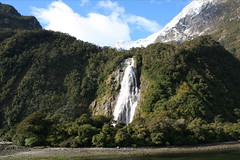
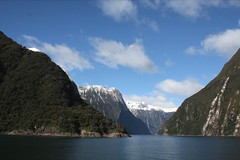
Day 14: Elm Wildlife Tour in Dunedin
After leaving the snow-covered ground of Queenstown, we hopped back on the Magic Bus and made our way to Dunedin, a small, but lively college town in the southeast of the island, also home to the world's steepest street. Immediately upon arriving, Mike and I were picked up by our Elm Wildlife Tour guide, who drove us out to the Otago Peninsula, where we visited a royal albatross colony, mingled with feisty sea lions on the beach, and spied on rare yellow-eyed penguins as they came home from a day at sea and greeted their loved ones. The best way to describe this adventure is with our photos up on Flickr.
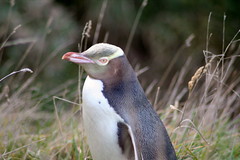
Day 15: Dunedin to Tekapo
We said farewell to Dunedin and it was on to Tekapo and its lake by the same name. On the way we made a quick lunch and site-seeing stop at the Moeraki boulders near Oamaru. We rolled into Tekapo rather early and went by their famous church which over looks the lake and is said to host more than 600 weddings a year. With not much to do in this little town and us quickly running out of New Zealand dollars we decided to walk up to the grocery store for a meal in that night. Next to the Tongariro Crossing this was the coldest we'd been in NZ. Luckily we layered up for the walk, but it was next to comical how strong the wind was blowing and how biting it was. We did the walk in record time and didn't leave the hostel until our departure the next morning.
Day 16: Lake Tekapo to Christchurch
Heading to our final Magic Bus destination, Christchurch, we made one stop to see New Zealand’s highest peak, the mighty Mt. Cook. Unfortunately, the weather that day was overcast and a large cloud sat right in front of the peak, not budging the entire time we were there. We bought a postcard instead. Sometimes that’s how it goes.
Christchurch, the largest city on the South Island, was a very cool city, known for its gothic cathedral situated in the center of town. Here we tried to catch up on our Flickr photos, and paid the insanely expensive price of $10 an hour for wireless internet at of all places, Starbucks, the only place in town we found with WiFi.
Day 17: Back to Auckland
Since we only had 18 days in New Zealand and needed to get back to Auckland for our flight out of the country, we took a flight from Christchurch on the east coast of the south island back up to Auckland on the northwest coast of the north island. When we arrived in Auckland the rain was coming down hard outside and neither we nor our bags got away without a good soaking. Though we didn't particularly like the shower facilities (one of the worst I've seen on our travels) at the Beyond Backers in Auckland, we decided to go back. One, we knew how to get there, and two, we left a bag in their baggage storage, so we returned for our last night in New Zealand. They also have wireless internet in their lounge, a big plus for us.
Day 18: Goodbye NZ!
Sadly enough, this was our final day in New Zealand. After checking out of our hostel, we took the Airbus to the airport, giving ourselves plenty of time to make our flight to Sydney. Of course, the Airbus, which usually takes about 20-30 minutes, took over an hour to get to the airport, partly because the bus driver decided to chat up every person on the street during his routine stops. After waiting in line to check-in and hand over our bags, we rushed to the security/exit customs area only to find an even more massive queue. While biting our nails and cursing the Airbus, we hear that our plane is calling for final boarding of all passengers. Then they began announcing that the 5 final passengers, including Mike and me, needed to proceed immediately to the gate for departure. I concluded that there was no way we were going to make it, but the line moved along and we finally made it through, throwing our bags on the security belt, and then making a sprint across the airport to our gate. We arrived winded and received glaring looks from the attendants as they checked our tickets and let us through. After settling in to our seats, Mike turned to me with a big smile, “See, we made it. We’re just keeping things interesting.” I responded with a roll of my eyes.
